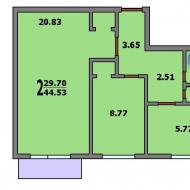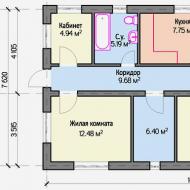
How pays a salary accountant. The procedure for calculating wages. Payroll
Oddly enough, many people for some reason are confident that the salary and salary is the same thing. Because of this, confusion occurs quite often: one amount is spelled in the contract, and the person gets less. Why? Let's figure out how to calculate the salary by salary and what you need to know.
Why salary from salary is different
First of all, you need to remember once and for all that these are two absolutely different concepts. Salary is what you get in accounting or card at the end of the month, and the salary is the amount prescribed in the contract, this is your wage, so to speak, in the "dirty" form. There are no various premiums, surcharges, taxes and deductions are not taken into account - this is, so to speak, the "zero rate", from which all subsequent calculations are produced. Therefore, it is very important to figure out how to consider salary by salary yourself, from which these calculations depend on and how to check their correctness.
Salary is a fixed amount, it does not affect any surcharge for harmfulness, not the amount of actually spent days, nor the amount and quantity of taxes. However, all these factors are very influenced by the amount you get at the end of the month.
What you need to know to calculate the salary correctly

- mary coefficients can be applied to wages;
- an employee can be accrued to premium and other payments;
- an employee can be fined for various violations;
- the employee may have obligations to pay alimony or other payments;
- may be issued an advance;
- insurance deductions pay the employer, and income tax is an employee;
All these, as well as some other factors reduce or increase employee wages, but do not affect its salary. Nevertheless, it is necessary to remember that, otherwise, significant errors may be allowed when calculating.
Calculation of salary
In the general case, for this you need to apply a very simple formula, which includes only 2 items:
- salary;
- income tax rate.
Everything is very simple: the wage is equal to the amount of the salary less the income tax, which in the Russian Federation is 13%.
Example:
A citizen N has a salary of 38,000 rubles, this item is clearly recorded in his contract. Over the past month, he worked in good faith all the days, fines and penalties did not have, but also did not earn award. Thus, at the end of the month N will receive:
38 000 - 13% \u003d 38 000 - 4 940 \u003d 33,060 p.

Example:
The same citizen N out of 23 working days actually went to work only 9 days, the rest he took at his own expense to travel to relatives. We consider:
- First, it is necessary to determine the average daily earnings N, based on its salary: 38 000/23 \u003d 1652.17 p.
- Now we calculate that part of the salary, which corresponds to the actual spent time: 1652.17 x 9 \u003d 14,869,53 p.
- Now we consider wages for 9 worked days: 14 869.53 - 13% \u003d 12 936.49 p.
Calculation of w / fees when taking into account premiums and premiums

However, in practice, such calculations are very rare, so let's see how to charge the salary by salary if the employee receives, for example, a premium in the amount of 15% of the salary and has a tax deduction for a child - 750 p. If we assume that all the same citizen N worked 21 days in a month of possible, then with all the conditions described, the calculation will look like this:
- 43 700/24 \u200b\u200bx 21 \u003d 38 237.50 p. - s / fee for spent time without deducting NDFL;
- 38 237,50 - 750 \u003d 37 487.50 p. - / fee for actual time, taking into account the tax deduction;
- 37 487.50 x 13% \u003d 4873,375 - NDFL, taking into account the use of deduction;
- 38 237.50 - 4873,375 \u003d 33 364,13 - C / fee per hand.
How to salary affects the district coefficient
Sometimes it is necessary to know how to calculate salary by salary in conditions when, due to complex climatic conditions, increased radiation or other harmful factors, an additional coefficient "for harm" is charged. Such a coefficient is also called the district, but it is not worth confused by the Northern Dumps, for the residents of the Far North. Such a coefficient is used in Udmurtia, Bashkortostan, Perm, Chelyabinsk, Vologda, Kurgan and other areas. The size of the coefficient is established by the Government of the Russian Federation separately for each region.
Example:
All the same citizen N, having a salary of 38 000 r. And the award in the amount of 15%, conscientiously worked out all days, no tax breaks. The coefficient for the region where our citizen N lives is 1.8. It should be used like this:
- 38 000 + 5 700 \u003d 43 700 - salary + premium;
- 43,700 x 1,8 \u003d 78 660 - C / fee taking into account the coefficient;
- 78 660 - 13% \u003d 68 434.2 p. - s / pl. to payoff.
How to check the correctness of the calculations

In labor legislation, it is clearly spelled out that the employee must be informed about all the allowances and retains made from its wages. In order to fulfill the requirements of the legislation, in enterprises usually give out the calculated leaves in which it is clearly spelled out how that the amount that at the end of the month you will see in your wallet or on the card.
Now you know exactly how to calculate salary by salary, and you can independently check the correctness of the calculations made by the employer. If you do not understand where this or that amount came from, or your calculations do not agree with those that you see in the received leaves, do not hesitate to seek explanations to the accounting department - there are all clarifications. You may have forgotten to take into account some parameter. To correctly calculate your wages, you need to know exactly all the deductions and dumps that concern you.
Oddly enough, many people for some reason are confident that the salary and salary is the same thing. Because of this, confusion occurs quite often: one amount is spelled in the contract, and the person gets less. Why? Let's figure out how to calculate the salary by salary and what you need to know.
Why salary from salary is different
First of all, you need to remember once and for all that these are two absolutely different concepts. Salary is what you get in accounting or card at the end of the month, and the salary is the amount prescribed in the contract, this is your wage, so to speak, in the "dirty" form. There are no various premiums, surcharges, taxes and deductions are not taken into account - this is, so to speak, the "zero rate", from which all subsequent calculations are produced. Therefore, it is very important to figure out how to consider salary by salary yourself, from which these calculations depend on and how to check their correctness.
Salary is a fixed amount, it does not affect any surcharge for harmfulness, not the amount of actually spent days, nor the amount and quantity of taxes. However, all these factors are very influenced by the amount you get at the end of the month.
What you need to know to calculate the salary correctly

- mary coefficients can be applied to wages;
- an employee can be accrued to premium and other payments;
- an employee can be fined for various violations;
- the employee may have obligations to pay alimony or other payments;
- may be issued an advance;
- insurance deductions pay the employer, and income tax is an employee;
All these, as well as some other factors reduce or increase employee wages, but do not affect its salary. Nevertheless, it is necessary to remember that, otherwise, significant errors may be allowed when calculating.
Calculation of salary
In the general case, for this you need to apply a very simple formula, which includes only 2 items:
- salary;
- income tax rate.
Everything is very simple: the wage is equal to the amount of the salary less the income tax, which in the Russian Federation is 13%.
Example:
A citizen N has a salary of 38,000 rubles, this item is clearly recorded in his contract. Over the past month, he worked in good faith all the days, fines and penalties did not have, but also did not earn award. Thus, at the end of the month N will receive:
38 000 - 13% \u003d 38 000 - 4 940 \u003d 33,060 p.

Example:
The same citizen N out of 23 working days actually went to work only 9 days, the rest he took at his own expense to travel to relatives. We consider:
- First, it is necessary to determine the average daily earnings N, based on its salary: 38 000/23 \u003d 1652.17 p.
- Now we calculate that part of the salary, which corresponds to the actual spent time: 1652.17 x 9 \u003d 14,869,53 p.
- Now we consider wages for 9 worked days: 14 869.53 - 13% \u003d 12 936.49 p.
Calculation of w / fees when taking into account premiums and premiums

However, in practice, such calculations are very rare, so let's see how to charge the salary by salary if the employee receives, for example, a premium in the amount of 15% of the salary and has a tax deduction for a child - 750 p. If we assume that all the same citizen N worked 21 days in a month of possible, then with all the conditions described, the calculation will look like this:
- 43 700/24 \u200b\u200bx 21 \u003d 38 237.50 p. - s / fee for spent time without deducting NDFL;
- 38 237,50 - 750 \u003d 37 487.50 p. - / fee for actual time, taking into account the tax deduction;
- 37 487.50 x 13% \u003d 4873,375 - NDFL, taking into account the use of deduction;
- 38 237.50 - 4873,375 \u003d 33 364,13 - C / fee per hand.
How to salary affects the district coefficient
Sometimes it is necessary to know how to calculate salary by salary in conditions when, due to complex climatic conditions, increased radiation or other harmful factors, an additional coefficient "for harm" is charged. Such a coefficient is also called the district, but it is not worth confused by the Northern Dumps, for the residents of the Far North. Such a coefficient is used in Udmurtia, Bashkortostan, Perm, Chelyabinsk, Vologda, Kurgan and other areas. The size of the coefficient is established by the Government of the Russian Federation separately for each region.
Example:
All the same citizen N, having a salary of 38 000 r. And the award in the amount of 15%, conscientiously worked out all days, no tax breaks. The coefficient for the region where our citizen N lives is 1.8. It should be used like this:
- 38 000 + 5 700 \u003d 43 700 - salary + premium;
- 43,700 x 1,8 \u003d 78 660 - C / fee taking into account the coefficient;
- 78 660 - 13% \u003d 68 434.2 p. - s / pl. to payoff.
How to check the correctness of the calculations

In labor legislation, it is clearly spelled out that the employee must be informed about all the allowances and retains made from its wages. In order to fulfill the requirements of the legislation, in enterprises usually give out the calculated leaves in which it is clearly spelled out how that the amount that at the end of the month you will see in your wallet or on the card.
Now you know exactly how to calculate salary by salary, and you can independently check the correctness of the calculations made by the employer. If you do not understand where this or that amount came from, or your calculations do not agree with those that you see in the received leaves, do not hesitate to seek explanations to the accounting department - there are all clarifications. You may have forgotten to take into account some parameter. To correctly calculate your wages, you need to know exactly all the deductions and dumps that concern you.
The procedure for calculating wages varies depending on which wage system is installed in the enterprise. For each of them a convenient formula has been developed, which makes it easy to make calculation.
From the article you will learn:
Wage
The term "wages" is called the remuneration of employees, which is carried out in accordance with the conditions recorded in the labor contract. The mechanism for calculating wages depends on which accounting system is set for a particular employee. The following main types of such systems are distinguished:
- timeless, in which employees receive payment of labor in proportion to the number of spent time;
- piecework, in which the work of workers is paid in proportion to the number of products produced;
- accordable, the basic principle of which is the payment of the agreed summary amount for performing a certain amount of work;
- commission, under which employees receive labor payment in the form of a certain percentage of the chosen indicator, which can be used by the cumulative income of the organization, enterprise revenue or other criteria.
Note! In some cases, other ways of organizing remuneration can be used to improve the efficiency of the company, for example, the establishment of floating salaries, when the cost of employee salaries depends on the overall indicators of the company's profitability.
More information about such a system you will find
Settlement of wages
The employee's salary is established on the basis of agreements between it and the employer. Existing labor legislation allows parties to regulate this issue on their own. The exception to this rule is the minimum amount of remuneration of workers (minimum wage), which is established at the legislative level.
At the moment, its size is set at the level of the subsistence minimum. In accordance with the Federal Law of 07.03.2018 N 41-FZ from May 1, 2018, it is 11,163 rubles per month.
In addition, a higher amount of minimum wage can be installed in certain subjects of the Federation by regional legislation. Current data on regional minimum wage you can find
Important! The procedure for salary accrual by employees is established by the Regulations on the payment of labor or other local document, which is approved by the order of the company's head, taking into account the opinion of the trade union (if available).
Additional payment conditions may also be administered by collective agreements or contracts. This information and the specific size set for an employee of the tariff rate, the cost of producing a unit of products or another indicator used to calculate employee wages is recorded in the employment contract of the employee. Information about the amount of payment is also prescribed in a regular schedule. About whether it is possible to indicate for workers plug size of salaries, talks our expert.
The procedure for calculating wages
The salary calculation of employees is made depending on the payment system that is installed for this category of employees. In large companies, there is a separate regular unit for this work, which is usually called an accountant for paying wages. If the company uses various wage systems, such a specialist must have experience in all relevant directions.
Calculation of wages at a piecework system for payment
Calculation of wages at a piecework system of payment for work is made taking into account the volume of production of products by this employee. This means that in order to apply such a mechanism, it is necessary to maintain a wage calculation table in which the amount of production is recorded.
The current legislation does not contain mandatory forms of accounting documentation. Therefore, the company has the right to independently develop blanks of primary accounting documentation, which will take into account the specifics of its activities. When it is developed, it is necessary to take into account the requirements of laws in terms of the preparation of primary accounting documents.
Unified form of accounting documents
For some activities, you can use the unified forms of documents established by the relevant regulatory documents. At the moment there are such forms for the following areas of work:
- travel sheets designed to take into account the volume of work performed by road carriers. Such documentation approved by the Resolution of the State Statistics Committee of Russia of November 28, 1997 No. 78;
- reports reflecting the amount of production using special construction machines approved by the Resolution of the State Statistics Committee No. 78;
- travel sheets of agricultural machinery, accounting sheets and other credentials intended for use in the agrarian industry. Forms of such documents are given in the Order of the Ministry of Agriculture of Russia of May 16, 2003 No. 750;
- other forms established by special regulatory documents of specialized departments.
If there are other forms of piecework at the enterprise, additional articles are added to the main salary size. For example, with a piece-premiss system, a composite part of the salary is a premium that is paid for achieving certain production indicators. Information on the procedure for salary accrual under a piece of progressive and indirect-piece systems
Payroll calculation with a time-based payment system
The calculation and accrual of wages is based on the amount established for the employee of the amount of payment of the time of the spent time. The following options can be used as such a unit:
- rate per hour of work;
- rate per day of work (work shift);
- bet for the month of work (salary).
Note! The choice of a specific rate is determined by the nature of the working activity of a particular employee and the specifics of the production process in the organization. Recommendations for choosing the most suitable option for a specific situation.
Salary calculation formula for a time-based system
The salary calculation of employees in the example with a time-based wage system is made on the basis of the following basic formula: the salary size is equal to the amount of spent time units at the rate set for this temporary unit. It should, however, consider the features of the final counting in the event that the employee works under the conditions of a monthly salary. In this situation, the size of his salary for a month does not depend on the number of working days in it.
For example, the payroll calculation of such an employee in January will be identical to the relevant settlement produced in April. The only condition for obtaining a full salary is to work out an employee of all working days in this month. By the way, count the number of such days in each of the months of 2018 is convenient with
If, in a specific month, the number of working days was worked out by the employee not completely, it must be taken into account when calculating wages. In such a situation, the calculation formula acquires the following form: the salary is equal to the size of the salary, which must be divided into the total number of working days in a month and multiplied by the number of actually spent days.
Salary calculation at a premium system
The above formula works for cases when a simple time-based payment system is installed for employees. At the same time, in practice, employers often use a premium system manner to motivate employees. In this case, the formula for calculating the payroll varies accordingly.
With a premium system to the main salary size, calculated as the payment of the number of time units or salary, the premium is added. Its size is established by the labor contract, a collective agreement or a local regulatory document.
Such a bonus can be established both in absolute terms and in percentage ratio with the size of the main part of wages or other parameters.
About how the calculation is made if during the month under consideration the employee received an increase in the salary,
Check test
Is the organization obliged to use the working time accounting form established by the legislation?
- no, their use in all cases is a recommendatory nature;
- yes, all organizations are required to use such forms if they are designed for its type of activity;
- they are obliged to use only government organizations.
Does the wage amount of the employee on the salary on the number of working days in the month?
- no, the worker will receive a salary in the established amount, if all working days has fully worked;
- yes, with a decrease in the number of working days in a month, the salary of the employee is proportionally reduced.
What document does not contain information about the amount and order of salary of the employee?
- labor contract;
- labor payment position;
- job description.
We will not consider the calculation of salaries in detail, but we will analyze the wiring, which are formed in accounting after making calculations for each employee.
Stages of work on salary accounting in the organization:
- payment of NDFLs and contributions.
For accounting for all operations related to pay for labor, 70 account "Calculations with wage personnel" is used. The loan of this account reflects accruals, the debit - NDFL, other retention and payments. Postings on salaries, deductions, accrual of personal income tax and insurance premiums are usually made by the last number of months for which salary is calculated. Postings on salary payment and payment of personal income tax and contributions - on the day of the actual translation (issuance) of cash.
Payroll
Spending costs are debited on the cost of production or goods, therefore, with 70 accounts correspond to the following accounts:
- for a manufacturing enterprise - 20 Score "Basic Production" or 23 Account "Auxiliary Production", 25 "Output Expenditures", 26 "General (Management) Costs", 29 "serving production and farms";
- for a trading enterprise - 44 "Sales costs" account.
Wiring looks like this:
D20 (44,26, ...) K70
This wiring is made on the total amount of the accrued salary for a month, or for each employee, if the accounting of 70 accounts is organized with the analyst at employees.
Wage hold
Holding from the salary reduces the amount of charges and take the account debit 70. As a rule, all employees have one retention - this is NFFL. Here 70 account corresponds to the 68 account "calculations for taxes and fees", wiring:
D70 K68.
In the wiring on other retention, the credit account is changing, depending on where it goes. For example, when held by the executive list in favor of a third party, 76 accounts "Calculations with different debtors and creditors" are used, wiring:
D70 K76
Accrual insurance premiums
In the wiring for insurance premiums 70 accounts are not involved, because They are not accrued to employees and are not held out of their salary.
Insurance contributions are the cost of production, i.e. Pass on the debit of accounts 20 (26.29, ...) or 44 in correspondence with a score of 69 "Calculations for social insurance and provision". 69 accounts usually have subaccounts for each contribution. Wiring:
D 20 (44, 26, ...) to 69
Payment of wages
After the salary is accrued on a loan of 70 accounts, and at the debit of account 70 of the account contained personal income and other retention, the remaining part is paid to employees. Payment can pass both from the cashier and through the bank (money is transferred to the accounts of employees from the settlement account of the organization), i.e. 70 The account corresponds to either with a score of 50 "Cashier", or with 51 accounts "Settlement account", wiring:
D70 K50 (51)
Listing NDFL and contributions
On the day of payments, the organization is obliged to pay NDFL and insurance premiums for injuries. The remaining insurance premiums pay up to the 15th day of the next month. Payment occurs from the current account (account 51), the debt is closed before the IFTS and Funds (accounts 68 and 69). Wiring:
D68 K51 - NDFL paid
D69 K51 - Contributions paid
Example of salary accrual with wiring
Employees were credited to the salary for January 2018, personal income tax was retained, insurance premiums were calculated. Accounting 70 accounts are conducted without analytics by employees, 69 accounts with subaccounts for each contribution. Salary costs and contributions are 20 account.
February 10, 2018 - the salary is paid, NDFL and insurance premiums in the FSS on injuries are paid.
02/15/2018 - insurance premiums paid to the FIU, FMS, FSS.
Contributions:
- in PFR - 16 500 rubles
- in FMS - 3,825 rubles
- FSS - 2,175 rubles
- FSS injury - 150 rubles
Postings for all operations:
date Wiring Sum Contents of operation 31.01.2018 D20 K70. 75 000 Accrued salary D70 K68.NFL 9 750 Painted NDFL Accrued insurance premiums: D20 K69.PFR 16 500 - in the FFR D20 K69.FMS 3 825 - in the FMS. D20 K69.FS1 2 175 - in FSS (time disability) D20 K69.FS2. 150 - in FSS (injury) 10.02.2018 D68.NFFL K51. 9 750 Listed NDFL D69.FS2 K51 150 FSss contributions listed (injuries) D70 K50 65 250 The salary of employees from the cash register 15.05.2018 Insurance contributions are listed: D69.PFR K51 16 500 - in the FFR D69.FMS K51 3 825 - in the FMS. D69.FS1 K51 2 175 - FSS (time. Powerability)
Book accounting in the online service Contour. Bukhgalkherry is convenient. Quick primary institution, automatic salary calculation, collaboration with the director.
Payroll carried out by methods, in many cases fundamentally different. We study their essence and order of use.
What are the types of salary?
In labor relations, you can distinguish several dozen payroll species. At a private enterprise, the salary may be presented (paragraph 2 of the provisions on the specifics of the procedure for calculating the average wage approved by the Decree of the Government of Russia of December 24, 2007 No. 922):
- payments at the rate or salary - for spent time;
- payments for contract prices;
- interest on sales (commission remuneration);
- non-monetary income;
- copyrighted fees;
- surcharges, surcharges, prizes, rewards for labor results;
- payments for special working conditions, etc.
In 2018, salary accrual in these species can be carried out using the widest range of methods. At the same time, the specified types of wages can be combined with any way among themselves - in accordance with the wage system operating in the enterprise.
You can learn more about the application of various wage schemes in the enterprise.
If we talk about traditional salary accrual schemes, then it is possible to attribute to those (Letter of state of the USSR, the Ministry of Finance of the USSR, the USSR State Committee No. 10-86 / 1080, the CSSU of the USSR from 10.06.1975 No. AB-162 / 16-127):
- a time-based scheme, which is based on the accrual of payments by salary based on the spent time;
- a piecework scheme, based on the accrual of salary for the measured objectively or evaluated on established criteria, the results of work.
Let us study more than how the salary is charged within the 2 most common calculation schemes - timeless and piecework.
How is the salary charge under time wage?
Timeless (alert-premium) wage is most often found in the 2 following varieties:
- When the salary is considered to be based on the monthly salary of the employee (supplemented in the prescribed manner prizes for the results of labor).
In this case, the formula is used to accrual wages:
Salary \u003d (OP / RD) × one
Salary - salary for the estimated period;
OP - official salary employee, complemented by prizes if available;
RD - the number of working days in a month, which includes the estimated period;
OD - spent days in the settlement period.
Attention! The payment of wages should be carried out at least 2 times a month (Article 136 of the Labor Code of the Russian Federation), so the billing period may not exceed half of the month (letter of Ministry of Labor Society of Russia dated 09/21/2016 No. 14-1 / B-911). At the same time, the salary accrual is displayed in Bugets in the last day of the month.
- When the salary is considered based on the tariff rate per 1 hour or 1 day.
In this case, formulas are used to accrual wages:
- with hourly wage:
Salary \u003d chtts × och
Chtts - hour tariff rate on the employment contract,
Och - the number of hours spent during the reporting period;
- with daily wages:
Salary \u003d DTS × OD,
where DTS is a day rate for an employment contract.
At the same time, in both cases, the employee receives the payment of weekends and holidays:
- when performing work on weekends and holidays - at a double tariff rate (Art. 153 of the Labor Code of the Russian Federation);
- when resting on such days - in accordance with the local standard (Article 112 of the Labor Code of the Russian Federation).
In the scenario under consideration, the calculation of the salary is carried out with the fact that the employer is obliged to establish monthly rules (Article 160, 162 of the Labor Code of the Russian Federation):
- in time of work;
- by work out.
The basis for such rules may be, for example, type indicators in the industry, in which the employer is operating.
When performing the rules established by the employer, an employee in any case receives a salary at least the minimum amount of wages established in the subject of the Russian Federation (Article 133 of the Labor Code of the Russian Federation).
Now - about how salary is charged under a piecework scheme.
Calculation of salary at a piecework wage system: nuances

With a piece of salary, as in the second embodiment of timeless wages, considered by us above, the employer also establishes monthly standards of working time and work out. The excess of the relevant rules may increase the piece of salary:
- Proportional to work out.
Example
Electrical engineering Ivanov works at the TV assembly plant. It receives a salary by a piecework scheme, within which the employer has established the norm on the assembly of 2 TVs within 8 working hours. When it is fulfilled, Ivanov receives 2,000 rubles (tariff: 1,000 rubles for 1 collected TV).
For each next, Ivanov TV receives 1,000 rubles, regardless of production volumes.
- Using progressive scale.
Example
Petrov Maker operates at the factory for the production of fasteners in the workshop for the production of bolts. He receives a piece of salary at which the employer establishes the production rate: 100 bolts for 8 working hours. When it is fulfilled, Petrov receives 390 rubles (tariff - 3 rubles 90 kopecks per 1 bolt).
For every 50 of the following collected bolts of Petrov receives 10 rubles per piece. For every 50, following them, - 20 rubles. For each subsequent bolt - 30 rubles.
In some cases, a regressive scale can also be applied. For example, when the company's production model requires employees as much as possible execution of planned indicators without significant exceeding (as an option, in order to increase the efficiency of control over raw materials and materials).
A separate type of salary is the one that is paid during the period of the employee's travel (Article 139, 167 of the Labor Code of the Russian Federation). We study the specifics of its calculation.
Calculation of salary on a business trip: nuances
The payment of a person who is on a business trip is a special kind of salary - average earnings during a business trip.
It is considered by the formula:
SC \u003d RDK × np,
SC - salary for the period of travel in the form of average earnings;
RDK - the number of business days as part of a business trip;
SZ - average employee earnings.
The SZ indicator is calculated by the formula:
Sz \u003d base / od
The base is the amount of earning employee for the estimated period;
One - the number of days spent during the estimated period.
For the estimated period, 12 months preceding the day of the employee departure on a business trip.
Indicator OD in 2017 is considered by the formula:
OD \u003d ME × 29.3 + odnm / kdnm × 29,3,
ME - the number of full months in the settlement period;
Odnm - the number of days spent in all incomplete months of labor activity in the settlement period;
KDNM - the number of calendar days in all incomplete months in the estimated period.
When calculating the indicator, the base is not taken out of vacation payments, hospital, other business-compensated by the employer, expenses and other payments, named in PP. 3, 5 provisions under Resolution No. 922.
When calculating the RDK indicator, the days of finding an employee on the way (including the day of departure from their city and the day of return to it).
Business trip on weekends: what is the salary
How to charge a salary for weekends during a business trip? This task is solved by the application of the formula:
RVK \u003d DT × pv × 2,
Dt - the day of the employee's day in accordance with the adopted remuneration system (letter of the Ministry of Labor Society of Russia dated December 25, 2013 No. 14-2-337);
RV - spent weekends.
DT indicator can be directly determined in the employment contract or is calculated by the formula:
DT \u003d OKL / RDM,
OKL - salary (with premiums and premiums, if provided for by the contract) for a month in which a person was on a business trip);
RDM - the number of working days in the corresponding month.
In addition to salaries in the form of an average earnings, the daily employee is also paid daily.
Learn how the daily day is calculated, you can in the article .
Calculation of salary and taxation in 2017-2018
The employee's salary, including those represented by vacation and travel, is subject to:
- NDFL at the rate:
- 13% - if the employee has a tax resident status;
- 30% - if the employee does not have a resident status.
In the case of the use of tax deductions, the NDFL at a rate of 13% is not charged in part of the salary amount within the limits of deduction. At the NDFL rate, 30% deduction cannot be applied.
NDFL at the salary is charged at the time of declaration of its income - on the last day of the month, for which the salary is calculated (paragraph 2 of Art. 223 of the Tax Code of the Russian Federation). Hold - at the time of payment. Listed in the budget - no later than the next business day after paying.
Thus, if the employee listed revenue until the end of the month, the NDFL is held and listed in the budget only with the next nearest payment.
- Contributions to social funds (the main part of which is charged with the mediation of the FNS):
- in the FIU;
- in FSS (without mediation, the FTS, the Fund charges contributions to injuries);
- in FFOMS.
Contribution rates are divided into standard and reduced, which are established for certain categories of enterprises. Contributions are charged on salary without deducting NDFL.
Learn more about the amount of bets on contributions to social funds you can in the article .
The timing of the payment of all contributions is until the 15th day of the month, for which the employee is accrued salary.
RESULTS
The order of salary accrual depends on the department adopted at the enterprise (enshrined in the employment contract): piecework and timeless. Wage due to the period of the employee is calculated in a special order.
















